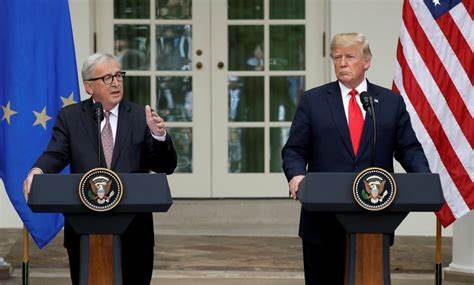🎧 Listen to This Article
In a major diplomatic move, the United States and European Union appear poised to finalize a comprehensive agreement addressing non-tariff trade irritants. Yet, with looming tariffs scheduled by both sides in July, the success of this pact could hinge on the more contentious tariff negotiations still unresolved.
- Non-Tariff Breakthroughs
• A draft “agreement on reciprocal trade,” circulated by the U.S. Trade Representative’s office, outlines targeted resolutions across key non-tariff domains—covering the EU’s Digital Markets Act (DMA), deforestation regulations, carbon border adjustment mechanisms, shipbuilding support, defense procurement, critical minerals, and U.S. energy exports.
• Highlights include:- Digital Markets Act: A freeze on enforcement actions—safeguarding U.S. tech giants during negotiations
- Deforestation Regulation: A further one-year delay to allow compliance, mirroring the EU’s own postponement into 2026 .
- Carbon Border Tariff: U.S. imports to be exempted for one year post-implementation .
- Energy & Methane Rules: U.S. energy exports will sidestep EU methane regulations during the transition .
- Tariff Tensions Persist
• Critical questions around the July 9 U.S. deadline for Trump’s threatened 20–50% reciprocal tariffs—and the EU’s retaliatory tariffs set for July 14—remain unresolved in the current draft.
• EU sources suggest steady acceptance of a permanent 10% baseline tariff to prevent more severe industry-specific rates.
• European unity is fragile: France seeks stronger countermeasures, while Italy and Hungary lean toward staying the course. - Next Steps & Strategic Stakes
• Negotiators explore multiple scenarios: a separate tariff deal, extending past the July deadlines, or even splitting non-tariff and tariff discussions.
• While U.S. negotiators have praised the EU’s proposals as a “credible starting point,” some European officials warn against unilateral concessions that might cost voter support.
• A potential “UK‑style” compromise (10% baseline tariff, followed by sector‑by‑sector talks) gains traction within the Commission.
Conclusion:
Although the non‑tariff agreement marks a significant step toward mutual economic cooperation, the unresolved July tariff showdown could define the pact’s success—or unravel it. Observers await whether negotiators can thread the needle between symbolic non-tariff gains and the more politically charged tariff hurdles.
For further details, clarification, contributions, or any concerns regarding this article, please get in touch with us at editorial@tax.news. We value your feedback and are committed to providing accurate and timely information. Please note that our privacy policy will handle all inquiries.



